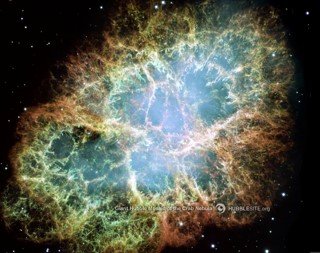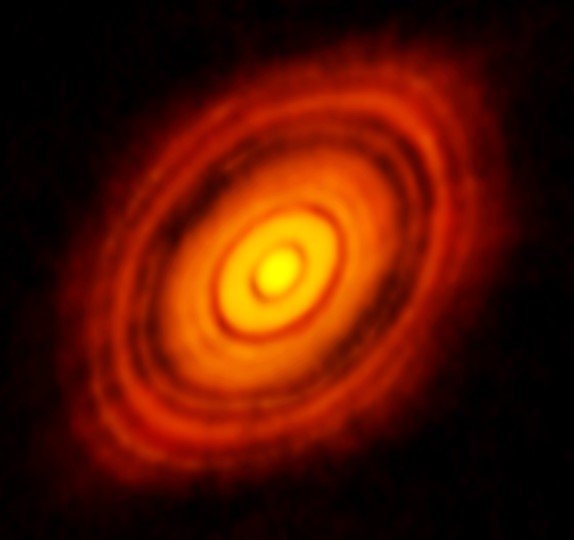Rick Carlson on Probing the Early Solar System
Rick Carlson is Director of the Earth and Planets Lab at Carnegie Science in Washington, DC. He uses mass spectrometers to measure the ratios of various isotopes in meteorites and in the tiny pre-solar grains often contained within them. He explains how variations in these ratios point to different pre-solar-system origins for these bodies. The challenge then is to infer what was going on in the solar nebula as the sun and planets were forming to result in these unexpected observations.
Listen to the podcast here or wherever you listen to podcasts.
Scroll down for illustrations that support the podcast.
Note - playing the podcast is not supported on Internet Explorer; please use any other browser, or listen on Spotify, Apple Podcasts, etc.
Podcast Illustrations
All images courtesy of Rick Carlson unless otherwise indicated.
The solar nebula formed out of a giant cloud of dust and gas such as the Eagle Nebula, which lies at a distance of 7,000 light years and is about 70 light years across. It is illuminated by stars that are forming within it.
Courtesy of NASA, ESA and the Hubble Heritage Team (STScI/AURA)
The series of diagrams (not to scale) illustrate how the solar system was formed. A. A giant molecular cloud starts to collapse. B. The solar nebula is formed with the young Sun surrounded by a circumstellar disk. C, D. Planets start forming out of the circumstellar disk, sweeping up material in their “feeding zone” as they grow. E. The gas and the smaller bodies have been accreted into the planets and the asteroid belt.
Courtesy of Plymouth State University
According to some theories, the formation of the solar system was triggered by the arrival of a shock wave from a nearby supernova, such as the Crab Nebula pictured here. The nebula corresponds to a bright supernova seen by Chinese astronomers in 1054.
Courtesy of NASA, ESA and the Hubble Heritage Team (STScI/AURA)
Photomicrograph of a silicon carbide pre-solar grain.
Courtesy of Zinner (2003), Treatise on Geochemistry
Barium isotope abundances of a pre-solar silicon carbide (SiC) grain compared to the solar barium isotope abundances. The scale on the left shows that for some of the barium isotopes (e.g., those with masses of 130 and 132 atomic units), the abundances in the pre-solar grain are 80% lower than in the sun.
These plots illustrate what happens when isotopic anomalies get diluted by mixing with other materials. Both the plots show the abundances of barium for material from the primitive Murchison meteorite. The plot on the left shows the results for residue that does not dissolve in acid. It looks similar to the pattern for the pure pre-solar grain above, though with a much smaller range of variation. The right figure shows the same plot for what is dissolved, i.e., leached out by the acid. The leach includes a range of pre-solar grains, and its pattern is complementary to that of the silicon carbide grain shown above. If the residue and the dissolved material are added together, the result is an isotopic composition for barium similar to that of the sun. This implies that the Murchison meteorite sampled a mixture of different types of pre-solar grains that on average provide a barium isotopic composition similar to the average solar composition.
Murchison Leach image from Qin et al. (2011), Geochimica et Cosmochimica Acta
The plot shows the oxygen isotopic composition of a range of pre-solar grains. Each grain is shown as a blue dot. The shaded regions show the isotopic compositions resulting from nucleosynthesis in supernovae, novae, and stars in the later stages of their evolution (AGB stars). The total range of oxygen isotopic composition of all Earth materials would fit inside one of the dots, and would sit where the dotted lines cross.
Courtesy of Larry Nittler
This image was produced by the Atacama Large Millimeter Array (ALMA), and shows a disk of dust 2,000 astronomical units across orbiting a young star called HL-Tau. The black rings are gaps in the red dust, and are probably regions of the protoplanetary disk where planets are forming and scooping up the dust.
Courtesy of ALMA (ESO/NAOJ/NRAO)
The ALMA radio telescope consists of an array of 66 antennas, each of which is a dish 12-meters or 7-meters across. The telescope operates at wavelengths of 0.32 to 3.6 mm and, depending on how the antennae are positioned, has a resolution between 0.004 and 0.2 arcseconds.
Courtesy of Clem & Adri Bacri-Normier (wingsforscience.com/ESO)
Meteorites and the Formation of the Earth
Chondritic meteorites provide us with samples of primitive solar system material. Their name comes from the small circular objects called chondrules that are the crystallization products of small melt droplets that were rapidly melted and cooled ”dust balls” in the early solar system. The white objects are called Calcium-Aluminum Inclusions (CAI) as they are composed of minerals rich in those elements that are some of the most refractory minerals – think of ceramics. CAIs are often regarded as the first objects to form from a cooling solar disk and yield the oldest ages of any material in the solar system at 4.568 billion years. The matrix in between the chondrules and CAIs consists predominately of hydrated magnesium silicates. Most of the presolar grains are found in the matrix, which is regarded as material that may never have reached high temperatures during accumulation of the meteorite parent body. A primitive meteorite such as this can be thought of as a sediment that is simply a collection of the various types of solid objects in the circumstellar disk at the time that planet formation began. The image shows a piece of the Allende meteorite, which is the largest carbonaceous chondrite found on Earth. The chondrules are about 2mm in diameter.
Courtesy of the National Museum of American History
Plot of titanium isotope ratios versus chromium isotope ratios for the Earth and different types of meteorite. It shows that for these isotopes, Earth sits in between the carbonaceous chondrites and the non-carbonaceous chondrites (colored points). SNC = Martian meteorites. The epsilon prefix on the axis legends indicates parts per 10,000 difference between the measured ratios and the corresponding ratio in terrestrial materials.
A plot of ruthenium and molybdenum isotope ratios as a function of distance from the Sun. The left plot indicates that terrestrial materials may be at the end of the range of solar system ruthenium isotopic composition, but in the podcast, Rick Carlson suggests that we may be missing a population that would lie beyond the Earth in such a plot.
In some early solar system scenarios, Jupiter formed early enough to effectively isolate the inner non-carbonaceous chondrite meteorites (red, NC) that were concentrated in the inner solar system from the carbonaceous chrondrites (blue, CC) in the outer solar system. As discussed in the podcast, Jupiter may also have blocked newly arriving supernova shock-wave material from penetrating the inner solar system, thus enabling inhomogeneities to develop in the solar disk.
Kruijer et al. (2017), PNAS, 114, 6712
The graphs illustrate how the isotopic composition of different elements can be used to determine which type of meteorites accumulated to Earth during various stages of its formation. Lithophile elements are those that concentrate in the silicate portion of the planet, so their isotopic composition averages all the material from which Earth was made because they were not sequestered in the core. Elements that are strongly siderophile, meaning that they concentrate in iron metal, would have been sequestered into the core as Earth grew. The more an element is concentrated in the core, the more likely its isotopic composition in the mantle reflects only the latter stages of accretion, whereas elements that are only somewhat siderophile will track longer periods of Earth accretion. Consequently, the isotopic composition of a highly siderophile element like Ru in the present Earth’s mantle will be controlled by the small amount (~0.5%) of Earth’s mass that accreted after core formation was complete. Elements with intermediate siderophile tendencies will average periods of Earth accretion that vary by how much of the element is sequestered into the core. Thus, the isotopic composition of a moderately siderophile element such as Mo will reflect the average of the last few percent of accreted material, whereas a weakly siderophile element such as Cr will average most of accretion with a slight bias towards the material accreted in the latter stages of Earth formation.
Dauphas (2017), Nature 541, 521















